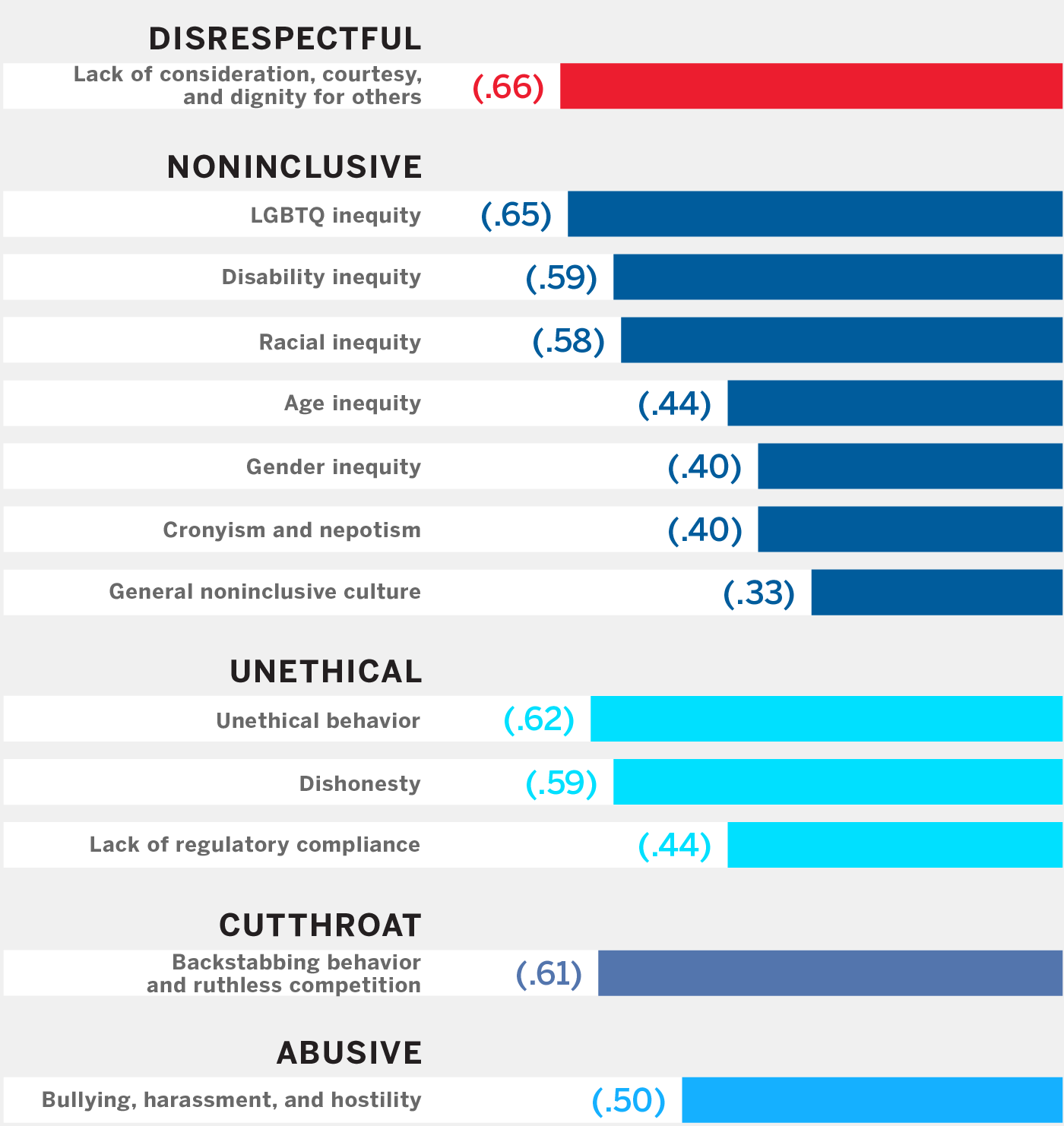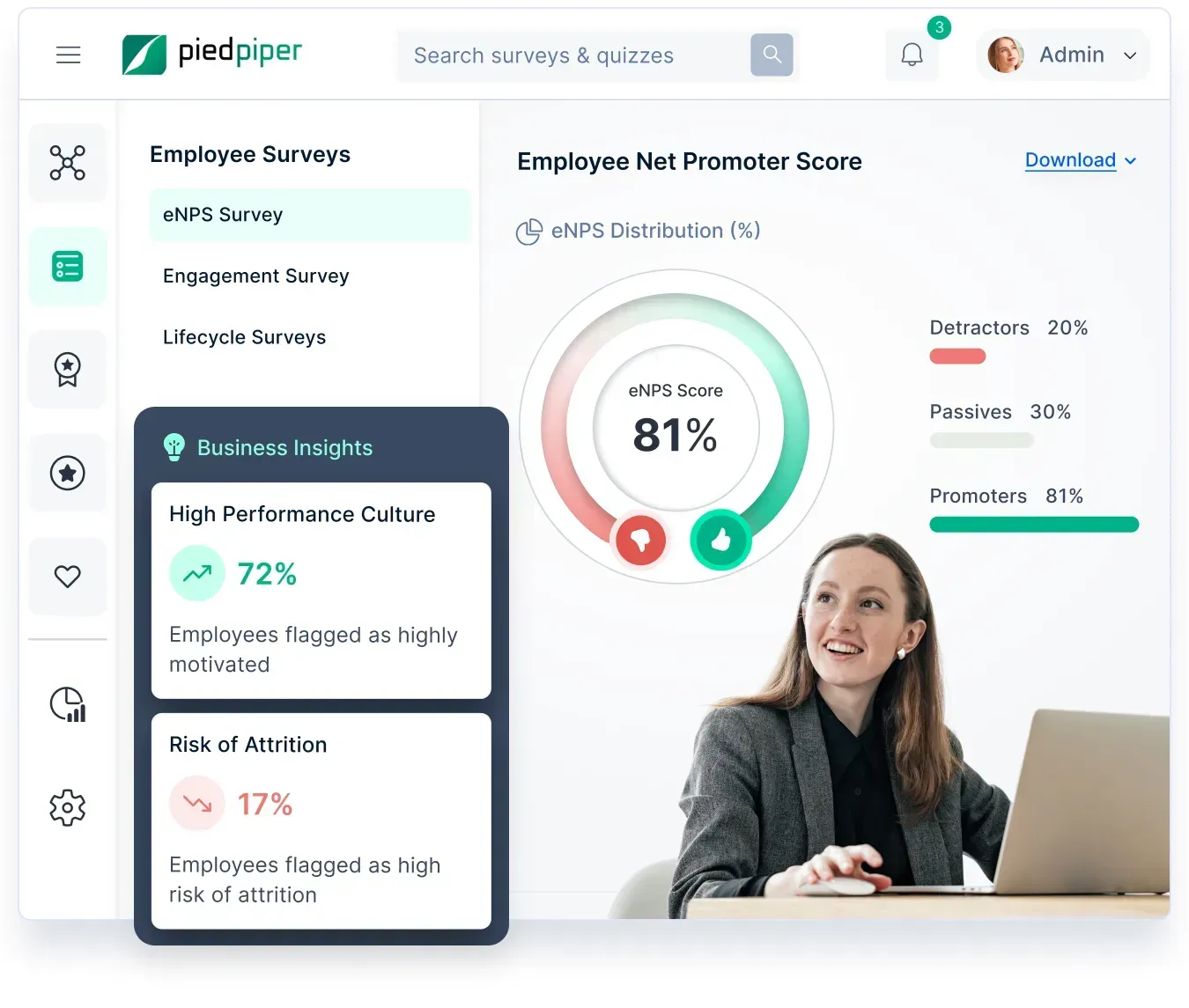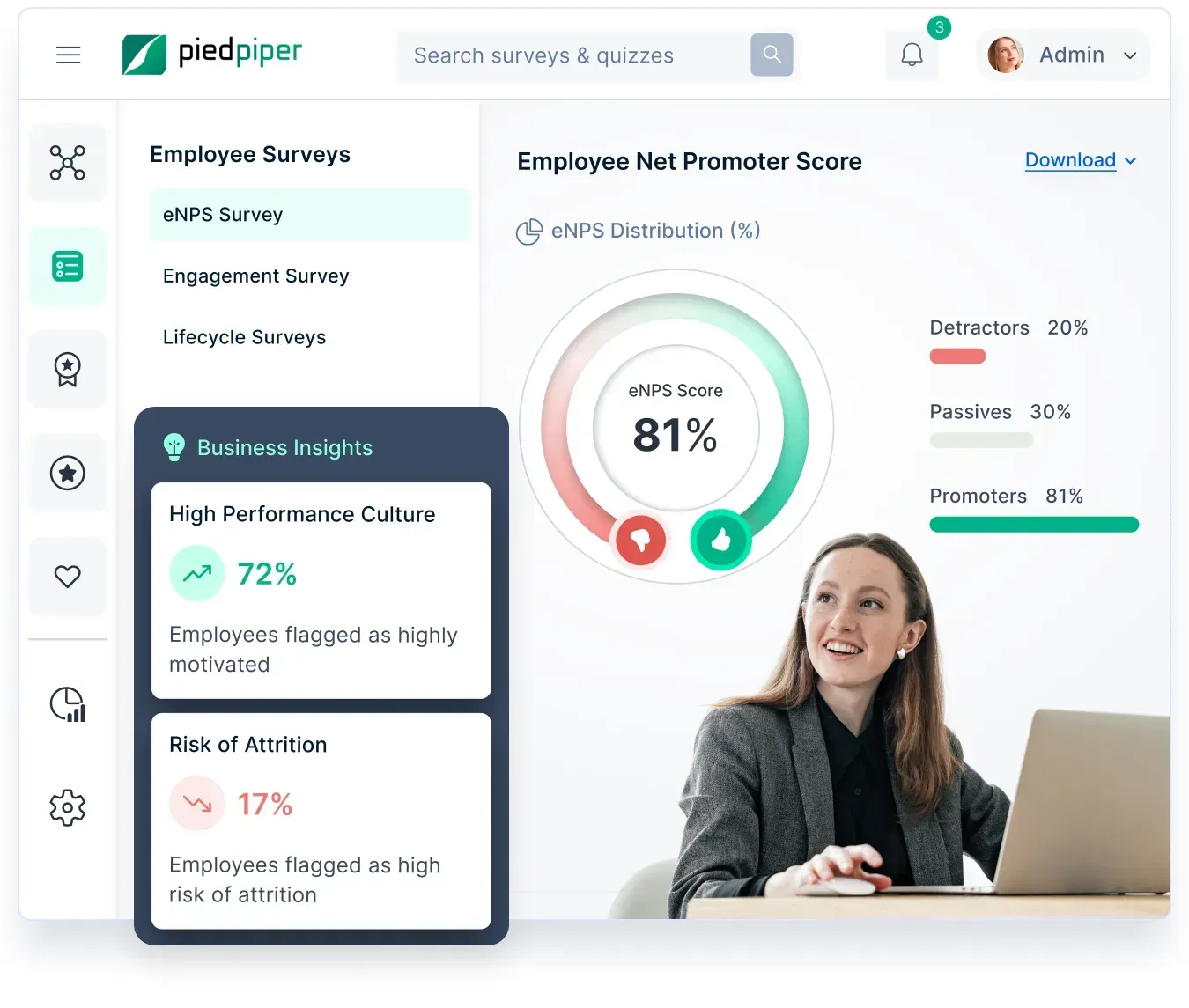On this page
- What do we understand by toxic culture?
- The toxic five culture attributes
- Impact of toxic work culture on employee and the organization
- Why every leader needs to worry about toxic culture at work?
- The first step to combating toxic workplace culture: Strategies to improve a bad workplace culture
- How Empuls helps identify and eradicate toxic culture
- Wrapping up
- FAQ's
Toxic culture is more than just an HR issue—it’s a powerful force that can silently undermine performance, derail strategy, and accelerate attrition. In fact, research shows it’s a stronger predictor of employee turnover than compensation. Yet many leaders still underestimate its reach.
Left unaddressed, toxic norms become embedded, shaping how people behave, interact, and even make decisions. The danger? It often operates in plain sight—disguised as “high standards” or “just the way things are.”
A notable example is Yahoo, which faced serious challenges with its workplace culture during Marissa Mayer's tenure as CEO. Her strict policies, including a ban on remote work, fostered an environment of distrust and dissatisfaction among employees. This led to a staggering 25% decline in employee morale and job satisfaction scores.
Consequently, turnover rates escalated to 20%, as many employees left out of frustration with management practices. Ultimately, Yahoo's difficulties in retaining talent stifled innovation and productivity, contributing to a decline in overall performance and highlighting the severe impacts of a toxic workplace culture.
This blog unpacks why no organization is immune—and why every leader must take culture seriously before it corrodes everything that matters.
What do we understand by toxic culture?
Bad culture, particularly in the workplace, is a negative environment that adversely affects employee morale, productivity, and overall organizational performance. It encompasses various detrimental behaviors, attitudes, and practices that can lead to significant issues within a company. The toxic culture at work often manifests in various forms, including:
- Bullying and harassment: This involves verbal or physical abuse, intimidation, or discrimination towards colleagues.
- Favoritism and nepotism: When individuals are treated differently based on personal relationships or biases.
- Micromanagement: Excessive control and monitoring of employees' work, leading to a lack of autonomy and trust.
- Poor communication: Inadequate or unclear communication channels lead to misunderstandings, confusion, and frustration.
- Lack of recognition and appreciation: When employees' contributions are not acknowledged or valued, leading to low morale and decreased motivation.
- Unrealistic expectations: When employees are given unreasonable or unattainable goals, leading to stress, burnout, and decreased job satisfaction.
- Negative gossip and rumors: Spreading false or harmful information about colleagues, creates a toxic and divisive atmosphere.
- Lack of accountability: When individuals are not held responsible for their actions or mistakes, leading to a culture of impunity and injustice.
A toxic workplace culture can have severe consequences for individuals and organizations. It can lead to decreased productivity, increased absenteeism and turnover, and damage an organization's reputation.
Additionally, it can harm employees' mental and physical health, leading to stress, anxiety, and even depression. Here’s a summary of findings from recent research on this topic.
-> According to an American Psychological Association survey, 19% of workers reported their workplace as very or somewhat toxic. Those in toxic environments were over three times more likely to experience mental health issues compared to those in healthier workplaces (52% vs. 15%).
-> The APA survey revealed that certain job types are more susceptible to toxic conditions; for instance, 31% of customer service workers reported verbal abuse, compared to 23% of manual laborers and 22% of office workers.
-> The survey also found that 22% of workers experienced harm to their mental health at work, with 22% reporting harassment in the past year, an increase from 14% in the previous year.
-> Research from MIT Sloan Management Review highlights that toxic culture was a major predictor of employee attrition during the Great Resignation, 10 times more powerful than compensation perceptions in predicting turnover. It is estimated that toxic workplace cultures cost U.S. employers nearly $50 billion annually before the pandemic.
-> Toxic environments can lead to increased healthcare costs for employers, with estimates suggesting that they added approximately $16 billion in healthcare expenses in 2008 alone due to stress-related illnesses.
The statistical evidence underscores the profound impact of toxic workplace cultures on employee well-being and organizational performance. Addressing these issues is not only crucial for enhancing employee satisfaction but also for reducing significant financial costs associated with turnover and health care.
The toxic five culture attributes
Toxic work culture isn't just an HR issue—it's a business risk. Based on findings from the MIT Sloan Management Review article, five specific cultural attributes have been identified as the most harmful to employees and organizational health. When left unchecked, these traits create a toxic environment in work settings and significantly impact retention, morale, and performance.

1. Disrespectful behavior
When employees feel undervalued or disrespected, trust erodes quickly. Disrespect can manifest in many ways, from condescending comments to dismissive attitudes and lack of recognition. This behavior undermines collaboration and fuels disengagement. Combating toxic workplace culture starts with fostering a baseline of respect and professional courtesy across all levels of the organization.
2. Noninclusive practices
A lack of inclusivity leads to feelings of exclusion and alienation. Employees who feel marginalized because of their identity, background, or ideas are less likely to speak up or contribute fully. Inclusion must go beyond surface-level initiatives—leaders should actively listen, engage diverse voices, and create spaces where everyone feels they belong.
3. Unethical behavior
When leadership or teams bend the rules or act without integrity, it sends a dangerous message. Ethical breaches damage internal trust and can also lead to reputational and legal consequences. Organizations with strong ethics policies and transparent practices are better equipped to avoid a toxic work culture and promote long-term stability.
4. Cutthroat competition
While healthy competition can drive innovation, a culture that rewards backstabbing or individualism over collaboration quickly becomes toxic. Employees should not feel they must sabotage others to succeed. Encouraging teamwork, knowledge sharing, and collective success is key to combating toxic workplace culture.
5. Abusive management
Perhaps the most damaging attribute is abusive leadership—micromanagement, verbal abuse, intimidation, or manipulation. These behaviors crush morale, stifle creativity, and accelerate turnover. Training programs, anonymous feedback mechanisms, and zero-tolerance policies are crucial to identifying and removing such behaviors before they escalate.
Impact of toxic work culture on employee and the organization
The impact of bad culture at work can have a dire impact. According to NIH, organizations with reputations for toxicity struggle to attract top-tier talent, hurting their competitive positioning.
Moreover, companies with toxic cultures risk damaging their employer brand, making it harder to attract top talent. This reinforces a cycle of poor culture and reduced performance. A negative workplace culture leads to:
- Decreased job satisfaction, causing employees to feel undervalued and disengaged from their work, ultimately affecting their performance.
- High turnover rates. It is common in toxic environments, as dissatisfied employees seek better opportunities, increasing hiring and training costs for organizations.
- Increased absenteeism. It occurs when employees take more sick days due to stress or burnout, disrupting workflow and impacting overall productivity.
- Low morale and negativity can spread among employees, creating a toxic atmosphere that hinders collaboration and innovation.
- High turnover and dissatisfaction. These are indicators of an unhealthy work environment.
Let us go through a statistical study of how bad workplace culture can impact the company.
-> According to MIT Sloan Management Review, employees exposed to such environments are 10 times more likely to quit.
-> The same study revealed that the turnover costs can range from 30-50% of an entry-level employee's annual salary to 200% for high-level positions.
-> According to the National Institute of Health, employees in toxic workplaces often face mental health challenges, such as burnout, anxiety, and stress, leading to a loss in productivity and increased absenteeism. Poor psychological safety significantly impacts employee well-being and organizational performance.
-> It also revealed that toxic behaviors—such as discrimination, bullying, and lack of inclusion—create environments where employees feel disengaged. This hampers collaboration stifles creativity, and undermines innovation.
-> A Randstad survey noted that over 40% of workers actively consider quitting due to issues tied to culture and balance.
-> A SHRM study revealed that companies with toxic environments experience higher turnover and disengagement, which costs U.S. businesses over $223 billion in five years.
-> According to the APA, a staggering number of workers report burnout caused by issues like poor management and lack of support.
These statistics illustrate the significant consequences of a negative workplace culture on both employees and organizational success. So, let’s cover the strategiesto combat toxic culture at work.
Why every leader needs to worry about toxic culture at work?
You might believe that a toxic work culture is a distant issue — one that plagues only high-profile corporate failures like Wells Fargo or The Weinstein Company. But that assumption can be dangerously misleading. The truth is that cultural toxicity is far more pervasive than many leaders realize, quietly eroding employee morale and organizational performance across industries.
Toxic culture is more common than you think
Data from Glassdoor reviews between 2016 and 2020 shows that 1 in 10 employees at large American companies cited elements of a toxic work culture. That’s more than 6,000 employees per company on average. Even more concerning, in some organizations, up to 22% of employees mentioned toxicity. When one out of every four employees highlights a toxic environment in work reviews, it’s no longer a fringe concern — it’s a systemic issue.
What this shows is that no company, no matter how stellar its reputation or Glassdoor rating, is immune. Even companies celebrated for their positive culture may still harbor hidden pockets of toxicity.
Microcultures can mask toxic behavior
Many organizations operate as a collection of microcultures — smaller cultural ecosystems shaped by business units, departments, geographic regions, or even individual leaders. These microcultures may deviate significantly from the broader corporate culture. While some teams might thrive, others might suffer in silence due to poor leadership, discrimination, or lack of inclusion.
For example, women, underrepresented minorities, and older employees often perceive workplace culture more negatively than their peers, highlighting how a toxic environment in work can disproportionately impact certain groups. This creates uneven employee experiences, where pockets of the organization foster inclusive collaboration while others breed discontent and disengagement.
Leadership matters more than ever
Every leader plays a pivotal role in shaping — or reshaping — workplace culture. Whether intentionally or unintentionally, leaders influence microcultures through their behavior, communication, and decisions. Therefore, recognizing and addressing cultural toxicity isn’t just a human resources responsibility; it’s a leadership imperative.
By acknowledging that toxicity can exist even in top-performing organizations, leaders take the crucial first step in fostering a healthier, more inclusive environment. Only through this awareness can they begin to dismantle toxic elements and create a culture where everyone can thrive.
The first step to combating toxic workplace culture: Strategies to improve a bad workplace culture
Before an organization can begin combating toxic workplace culture, leaders must recognize that toxicity might be lurking beneath the surface — even in environments perceived as healthy. It’s not enough to assess culture based on high-level averages across divisions or global regions. True cultural insight comes from digging deeper, analyzing team-level dynamics, and understanding the impact of individual leaders on the day-to-day experiences of employees.
Averages can obscure just as much as they reveal. Leaders who want to drive meaningful change must go beyond the surface to uncover hidden toxicity and address it at its source.
Improving a toxic workplace culture requires a systematic approach that involves commitment from leadership, clear communication, and active participation from all employees. Here are key strategies to consider:
Put your people first
One of the most powerful ways to shift away from a bad culture at work is to adopt a people-first mindset. A people-first culture prioritizes employee wellbeing, growth, and connection over pure profit. Employees today are more likely to stay engaged and committed when they feel seen, heard, and valued.
Start by learning what your employees need to succeed. Use wellness surveys, one-on-one conversations, or team feedback sessions to uncover barriers they face and brainstorm collaborative solutions. When employees feel supported and involved in shaping their workplace, they’re more motivated to perform and stay loyal.
Check in regularly
One of the simplest yet most effective tools for preventing toxic work culture is regular, meaningful check-ins. Research shows that employees who check in with their managers weekly are:
- More than twice as likely to trust and respect their leaders
- Five times less likely to be disengaged
- Nearly twice as likely to believe they have growth opportunities
These frequent touchpoints encourage open communication and build psychological safety. They help managers identify stressors early, understand employee motivations, and provide timely support—creating a more resilient, engaged workforce.
Role model expectations from the top
Leadership plays a pivotal role in shaping workplace behavior. Leaders should be held to the same (or higher) standards as the rest of the organization. When leaders consistently model transparency, empathy, and respect, they set a clear precedent for others to follow.
Consider offering leadership training focused on identifying and correcting toxic behaviors. Providing guidelines for promoting positivity and inclusivity can also ensure that leadership remains aligned and proactive in fostering a healthy work environment.
Hire the right people
Fixing bad culture at work isn’t just about changing behaviors—it's also about hiring employees who reflect your desired culture. Prioritize candidates with team-oriented attitudes, strong interpersonal skills, and a history of collaboration. While skills can be taught, toxic tendencies often prove difficult to correct.
Audit your hiring process if toxicity persists. Consider how you source candidates and what screening methods you use to evaluate their cultural fit. A proactive approach to hiring can prevent future issues and support a healthier, values-driven organization.
Recognize and reward the right behaviors
Appreciation is a cornerstone of combating toxic workplace culture. Employees who feel recognized for their efforts are generally more motivated and connected to their work. Simple thank-yous, shout-outs in team meetings, or structured recognition programs can reinforce positive behavior and improve morale.
Peer-to-peer recognition is equally valuable—it builds mutual respect and camaraderie across teams. Rewards like bonuses, extra time off, or even small tokens of appreciation can also go a long way in nurturing a culture of gratitude and belonging.
Offer flexible work arrangements
Toxicity can be intensified by rigid workplace policies that don’t align with employees’ needs. Offering flexible work options—whether it’s remote work, hybrid models, or flexible hours—shows that you trust your employees and respect their preferences.
According to Workhuman iQ, employees working in their preferred setup are 1.6 times more likely to feel highly engaged and significantly more connected to their colleagues. When employees have a say in how and where they work, it supports productivity, emotional wellbeing, and retention.
Fixing a toxic environment in work isn’t an overnight task—but by putting people first, promoting transparency, making thoughtful hires, and celebrating wins, you can shift from a toxic culture to a thriving one. It’s about intentionally creating an environment where people feel safe, respected, and empowered to do their best work. That’s why you need Empuls.
How Empuls helps identify and eradicate toxic culture
Toxic workplace culture is more than an HR inconvenience — it’s a business threat. From increased attrition to plummeting morale, the ripple effects can be devastating. But tackling toxicity isn’t just about removing bad behaviors — it’s about building a healthier, values-driven culture. That’s where Empuls steps in.
1. Listen, measure, and act with Empuls surveys

Empuls' powerful survey capabilities help surface hidden toxicity through:
- eNPS & Pulse Surveys: Measure sentiment and loyalty with scientifically designed questionnaires, enabling you to pinpoint morale issues before they snowball.
- 360-Degree Feedback: Promote transparency and self-awareness through multi-rater feedback — ideal for identifying micromanagement, favoritism, or unethical behavior at leadership levels.
- Lifecycle Surveys: From onboarding to exit, understand every phase of the employee journey to prevent toxic microcultures from taking root.
AI-backed sentiment analysis from Empuls’ bot, Em, adds another layer by distilling open-ended feedback into actionable insights.
2. Foster transparent communication through social intranet

Toxicity thrives in silence. Empuls’ social intranet breaks down walls:
- Company-wide town halls and AMA sessions enable open conversations between leadership and employees.
- Community groups support connection around shared values, interests, or roles, building inclusivity and belonging.
- Content moderation powered by AI ensures respectful dialogue, automatically flagging inappropriate posts.
3. Build a culture of appreciation with recognition tools

One of the key drivers of toxic culture is lack of recognition. Empuls counters this with:
- In-the-moment peer-to-peer and manager-driven recognition, tied to core values.
- Automated award creation and nudges from Em ensure no one is left unseen — reducing favoritism and improving equity in recognition.
- Wall of Fame & Wishboards create public celebration spaces, reinforcing positive behaviors.
4. Reduce burnout with perks and flexibility

Toxic culture often stems from burnout and rigid policies. Empuls helps:
- Deliver personalized fringe benefits and perks via Lifestyle Spending Accounts (LSAs), allowing employees to choose what matters most.
- Automate celebrations for milestones, like work anniversaries and birthdays — ensuring no one’s efforts go unnoticed.
5. Empower leaders with data and insights

Managers are crucial in shaping microcultures. Empuls equips them with:
- Real-time recognition insights, identifying team members who are overlooked or overly celebrated.
- Engagement analytics and nudges to intervene early when sentiment drops.
Why choose Empuls to tackle toxic culture?
✅ Scientifically backed survey models designed with SHRM
✅ Real-time engagement metrics and trend analysis
✅ Cross-platform availability — mobile, Teams, Slack, and more
✅ Customizable to reflect your unique company culture
✅ Proven impact: 87% reduction in attrition, 1.5x revenue growth reported by customers
No tool can single-handedly fix a toxic culture. But with Empuls, organizations get a powerful ally to surface hidden issues, celebrate the good, and nurture the culture they aspire to have — not the one they’ve inherited. Schedule a call now!
Wrapping up
By implementing these strategies, organizations can create a healthier and more positive work environment that benefits employees and the organization.
Addressing toxic culture at work is critical to creating a thriving and sustainable workplace.
Don't let toxic culture define your workplace. Take action today to create a healthier, more positive environment for everyone.
FAQ's
1. How do you fix bad culture in the workplace?
Implement open communication, recognize employee contributions, and promote teamwork to create a positive environment.
2. What are toxic cultures at work?
Toxic cultures at work are environments where negative behaviors, such as hostility and disrespect, thrive, harming employee morale.
3. What are the red flags of company culture?
Red flags include high employee turnover, frequent conflicts, lack of transparency, negative attitudes, and low employee morale.
4. What is an example of a toxic work culture?
An example includes a workplace where gossip is rampant, employees feel undermined, and there is a lack of support or recognition from management.
5. What qualifies as a toxic work environment?
A toxic work environment is characterized by persistent negativity, high employee turnover, lack of trust, poor communication, and behaviors such as bullying or harassment.
6. How do you know if work culture is toxic?
Signs of a toxic culture include low morale, high stress levels, frequent complaints about management, lack of collaboration, and an atmosphere of fear or distrust.


















